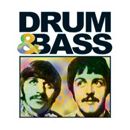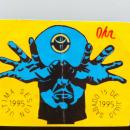Bueno , quizas a alguno le interese.
Lo primero el "minimal techno" que decís , es la cosa mas pasada y aburrida que ha existido en la electrónica , y ha hecho que toda la industria se llene de producciones medio hechas que suenan con los cuatro mismos "ruiditos" que hacen que la calidad...brille por su ausencia. Basura napolitana que hace que el mercado se haya inundado de productores mediocres pero vendibles.
Ademas del imperio M_nus , es innegable el acierto comercial que han tenido , la mayoria de los artistas en los ultimos años se han decantado por esta new wave...que hace que encima a todo se le llame "minimal". Cuando en el fondo la mayoria de los mezclas navega a medio camino entre el techno , el house o la mierda que se quieran ocurrir poner.
No quiero decir que todo lo catalogado con esta etiqueta "minimal techno" sea una mierda , como siempre habra producciones increibles (mal etiquetadas) de artistas increibles que se haya visto adoptados.
Pero si de verdad quereis hablar con propiedad , os recomiendo que dejeis de usar etiquetas y penseis que el minimal techno es lo que pinchais. Minimal techno es otra cosa , mucho mas antigua y mágica. Es Maurizio , es Basic Channel , es Robert Hood retorciendo knobs. Es toda la puta serie de Studio1 que habría que escuchar antes de poder pronunciar la palabra. Asi que intentar ir mas alla y profundizar en lo que pinchais , en lo que os gusta y dejaros de buscar temas en sesiones de otros. Buscar música que no sea caduca , que podais pinchar toda la vida por que vaya de acuerdo a lo que sentis y que quereis expresar. Dejar de querer ser como Richie , Ricardito o Sven, como Magda o como Troy .......o John , o Jessie o quien cojones querais ser.
Y pensar en ser vosotros mismos.
Por lo demas..esto es minimal techno , aprendamos a usar bien las etiquetas (aunque yo a la hora de pinchar solo me guio por la onda de mi corazon).
Minimal techno is a form of electronic dance music (EDM) that is considered a minimalist sub-genre of techno. It is characterized by a stripped-down[1] aesthetic that exploits the use of repetition, and understated development. This style of dance music production generally adheres to the motto less is more; a principle that has been previously utilized, to great effect, in architecture, design, visual art, and Western art music. The tradition of minimalist aesthetics in Western culture can be traced to the German Bauhaus movement (1919 to 1933). Minimal techno is thought to have been originally developed in the early 1990s by Detroit based producers Robert Hood and Daniel Bell.[2][3]
Contents
[hide]
* 1 Style
* 2 Origins
* 3 Development
* 4 Artists and labels
* 5 See also
* 6 References
[edit] Style
In an essay published in the book Audio Culture: Readings in Modern Music (2004), music journalist and critic Philip Sherburne, asserts that minimal techno uses two specific stylistic approaches, one being skeletalism, and the other massification.[4] According to Sherburne, in skeletal minimal techno, only the core elements are included with embellishments used only for the sake of variation within the song. In contrast, massification is a style of minimalism in which many sounds are layered over time, but with little variation in sonic elements. Today the influence of minimal styles of House music and Techno are not only found in club music, but becoming more commonly heard in popular music. [5] Regardless of the style, minimal Techno corkscrews into the very heart of repetition" so cerebrally as to often inspire descriptions like 'athenian', 'clinical', 'mathematical', and 'scientific.'[6]
The artistic sense of the word, finding it too "arty", so it is here that comparisons between the music that was being produced in Detroit and other forms of minimalism fail.[3] Robert Hood describes the situation in the early 1990s as one where techno had become too "ravey", with increasing tempos leading to the emergence of gabba. Such trends saw the demise of the soul infused techno that typified the original Detroit sound. Robert Hood has noted that he and Daniel Bell both realized something was missing from techno in the post-rave era, and saw that an important feature the original techno sound has been lost. Hood states that it sounded great from a production point of standpoint, but there was a 'jack' element in the [old] structure. People would complain that there's no funk, no feeling in techno anymore, and the easy escape is to put a vocalist and some piano on top to fill the emotional gap. I thought it was time for a return to the original underground.[3]
The minimal techno sound that emerged at this time has been defined by Robert Hood as: a basic stripped down, raw sound. Just drums, basslines and funky grooves and only what's essential. Only what is essential to make people move. I started to look at it as a science, the art of making people move their butts, speaking to their heart, mind and soul. It's a heart-felt rhythmic techno sound.[7]
[edit] Origins
In his essay Digital Discipline: Minimalism in House and Techno[4] Philip Sherburne also proposes what the origins of Minimal techno might be. Sherburne states that, like most contemporary electronic dance music, minimal techno has its roots in the landmark works of pioneers such as Kraftwerk and Detroit Techno's Derrick May and Juan Atkins. Minimal techno focuses on rhythm and repetition instead of melody and linear progression, much like classical minimalist music and the polyrhythmic African musical tradition that helped inspire it. [8] By 1994, according to Sherburne, the term "minimal" was in use to describe any stripped-down, Acidic derivative of classic Detroit style.[9]
Los Angeles based writer Daniel Chamberlin, attributes the origin of minimal techno to the German producers Basic Channel and in doing so fails to credit the contributions of Robert Hood or mention the influence of Hood, and other members of Underground Resistance, on the Berlin techno scene of the early 1990s (the scene out of which Basic Channel emerged).[10] Chamberlin draws parallels between the compositional techniques used by producers such as Richie Hawtin, Wolfgang Voigt, and Surgeon and that of American minimalist composer Steve Reich, in particular the pattern phasing system Reich employs in many of his works; the earliest being "Come Out". Chamberlin also sees the use of sine tone drones by minimalist composer La Monte Young and the repetitive patterns of Terry Riley's "In C" as other influences.[11] Sherburne has suggested that the noted similarities between minimal forms of dance music and American minimalism could easily be accidental; he also notes that much of the music technology used in EDM has traditionally been designed to suit loop based compositional methods, which may explain why certain stylistic features of minimal techno sound similar to works of Reich's that employ loops and pattern phasing techniques.[12]















